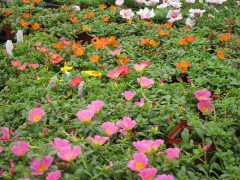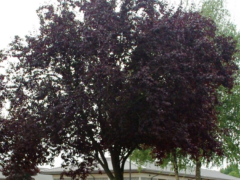
moss rose
Portulaca grandiflora
A classic maintenance free annual with fancy rose-like blooms all summer. Often self-seeding in garden … Continued
 Hummingbirds, bees and butterflies are well-known pollinators, but there are thousands of unsung pollinator heroes, including moths, wasps, flies, and beetles, many mammals, birds, and reptiles, who also take on the job.
Hummingbirds, bees and butterflies are well-known pollinators, but there are thousands of unsung pollinator heroes, including moths, wasps, flies, and beetles, many mammals, birds, and reptiles, who also take on the job.
Pollinators move from plant to plant, fueling up with pollen and nectar from blooming trees, shrubs, perennials, annuals, vegetable plants, and herbs. As they move, the pollinators transport and deposit pollen, fertilizing plants and allowing them to reproduce.
Pollinator plants can be native and non-native, but not all flowering plants are equal when it comes to providing the highest quality protein-rich pollen. Many hybrids don’t even produce pollen at all. The following list includes pollen-rich plants to include in your garden to provide pollinators with food.
Local butterfly expert Lenora Larson has created these informational handouts. You can download them here!
• Butterflies: Flying Flowers in your Garden!
• A Vital Connection: Native Plants and Butterflies
• Long Lips Farm Caterpillar Foodplants
• Butterfly Bartending: Nectar Flowers
• Long Lips Farm: Selected Butterfly Nectar Flowers
• Bee Friendly: Plants for Bees and Other Pollinators
Since 1970 the population of North American birds has dropped nearly 30% — almost three billion birds have vanished from our forests, grasslands, and backyards in less than a human lifetime. It’s a chilling fact that makes it clear that we must act as individuals to help ensure their survival.
Most importantly, ninety-six percent of all terrestrial bird species rear their young on insects so it is also important to grow plants that feed insects to provide a well-rounded habitat in your garden.


Portulaca grandiflora
A classic maintenance free annual with fancy rose-like blooms all summer. Often self-seeding in garden … Continued

Portulaca grandiflora
Large blooms cover these low-growing drought tolerant succulents through the summer. Needs almost no care … Continued

Potentilla fruticosa 'Fargo' Dakota Sunspot®
Blooming from midsummer until frost, this compact shrub features bright yellow flowers and bright green … Continued

Poterium sanguisorba
Plants have gorgeously serrated foliage and grow to about 1′ high and wide. Not fussy, … Continued

Prunus armeniaca
Apricot trees produce beautiful, fragrant blooms in early spring. One of the earliest stone fruits … Continued

Prunus serotina
This native ranges from southeastern Canada through the eastern US, and west to Texas. White … Continued

Prunus avium
Cherry trees require full sun and sharply draining fertile soil. Full sun is defined as … Continued

Prunus persica var. neupersica
Nectarines can be used in the same way as peaches — genetically, the only difference … Continued

Prunus x 'Pisnshzam'
A stunning weeping tree with striking early spring color. Trees are blanketed with beautiful, fragrant … Continued

Prunus domestica/salicina
Plum trees need full sun to produce sweet fruit and flower buds for the next … Continued
Prunus pumila 'UCONNPP002'
Attractive glossy blueish-green leaves turn shades of yellow, orange, and red in the fall. Spring … Continued

Prunus cerasifera ‘Krauter Vesuvius’
Grows as a dense, upright-rounded tree 15-20’ tall. A very popular ornamental landscape tree with … Continued